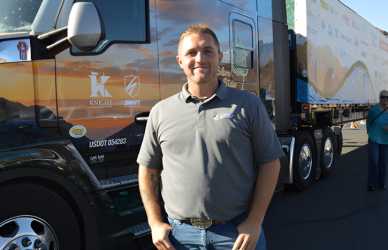During a session at the Truckload Carriers Association’s 2024 Safety and Security Meeting, three trucking and insurance leaders shared their insights on how executives can implement technologies to enhance safety culture within their companies.
The conversation also aimed to provide truckers with practical steps and strategies to minimize accidents, key metrics to track, and the importance of leadership in promoting a safety-first mindset.
“One of the things that I look at more frequently is speeding,” Fortune Transportation Co. CEO Perry Olson said June 2. “Not so much as speeding, but where it’s occurring.”
“If I’ve got somebody speeding in Montana on an interstate, that’s not where I need to focus. But if I’ve got somebody who’s speeding in a construction or a school zone, that’s more important. “Olson also noted that he monitors various driver issues beyond the Federal Motor Carrier Safety Administration’s Compliance, Safety, Accountability metrics.
Mark Seymour, CEO of Kriska Transportation, added, “I think we all understand that safety is not negotiable,” Kriska Transportation CEO Mark Seymour said. “You can save a little money now, but you’re going to pay for it later. It’s tough to restart what you’ve stopped. It needs to be there all the time.” When asked about technology, Olson highlighted the benefits of forward- and driver-facing cameras. “There’s virtually zero debate about the value of forward-facing cameras,” Olson said. “But we employed driver-facing cameras in the early days. Driver-facing cameras provide data, but then what do you have to do with that data?” Seymour agreed, noting that while they don’t use driver-facing cameras, forward-facing cameras have been a game-changer for coaching, accident mitigation, and responsibility.
Mike Miller, general manager for Progressive Insurance Fleet Programs, discussed how insurance companies are leveraging data to create meaningful metrics. “Over time, lots of vendors are working with the data to give you some ideas about behaviors,” Miller said. “You want to either have the data, or you don’t want to have the data. Understand that insurance companies are going to be looking at that, and it’s going to affect your rates over time.”
Seymour reflected on his experience with acquisitions, mentioning that they have completed about 25, but they are not without imperfections. He emphasized that safety must be a fundamental aspect and noted that they have learned from their past errors, realizing the importance of asking the right questions.
He also highlighted the significance of having operators under supervision, stating that professional drivers are essential to the business as they generate revenue. Ensuring that these drivers know who they report to is crucial.
Source: Transport Topics











